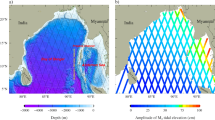Abstract
Eddies and planetary waves are identified as one of the important factors that control the dynamics of the Arabian Sea. During 10–14 January 1990, Ignat, Paulyuchenkov (USSR ship) conducted an experiment in the central Arabian Sea and of late TOPEX/POSEIDON satellites collected data on sea surface height (SSH) anomalies of the Arabian Sea. These data sets give an opportunity to understand the characteristic of eddies and planetary waves in this region during winter. The geostrophic flow revealed three anticyclonic and two cyclonic eddies of diameters ranging from 75 to more than 150 km from surface to subsurface levels. Current speeds around different eddies were maximum at surface and varied from 9 cm/s to 25 cm/s (at the middle point between the center and periphery). The occurrence of eddies were further investigated with the TOPEX/POSEIDON altimetry for the years 1993–97. The analysis revealed multiple eddies of diameter 100 to 550 km occur every year with maximum number of eddies during 1997 and minimum during 1995. The calculated speed varied between 8–30 cm/s around various eddies.
Longitude-Time plots showed annual Rossby waves generating at the eastern Arabian Sea and propagating westwards with a phase speed of ~ 10 cm/s along 16° N. Further, it was observed that these waves arrived in the study area by January. In addition, another positive anomaly of SSH was found generating at the western Arabian Sea simultaneously and extended up to the study region by April–June. Time series of SSH at selected locations along 16°N revealed many small-scale oscillations and their spatial variability. These oscillations were delineated using the FFT analysis. Other than the Rossby wave, the major components at the study region were 40–60 and 26–32 day oscillations. The implications of these long period waves associated with eddies are discussed.
Similar content being viewed by others
References
Bruce, J.G., Johnson, K.V. and Kindle, J.C. (1994). Evidence for eddy formation in the eastern Arabian Sea during the northeast monsoon. J. Geophys. Res.,99: 7651–7664.
Bruce, J.G., Kindle, J.C., Kantha, L.H., Kerling, J.L. and Bailey, J.F. (1988). Recent observations and modeling in the Arabian Sea Laccadive High region. J. Geophys. Res.,103: 7593–7600.
Cutler, A. and Swallow, J. C. (1984). Surface currents of the Indian Ocean (to 25 S, 100 E) (Compiled from historical data archived by the Meteorological Office, Bracknell, UK), Institute of Oceanographic Sciences, Technical Report 18, pp 8 and charts 36.
Gill, A.E., Green, J.S.A. and Simmons, A.J. (1974). Energy partition in the large-scale ocean circulation and the production of mid-ocean eddies. Deep-Sea Res.,21: 499–528.
Hareesh Kumar, P.V. and Sanilkumar, K.V. (2001). Long period waves in the coastal regions of the north Indian Ocean. Presented in Nat. Symp. On Advances in Remote Sensing Technology with special emphasis on high resolution imagery, held at Ahmadabad from Dec 11–13, 2001.
Hastenrath, S. and Lamb, P.J. (1979). Climatic Atlas of the Indian Ocean. Part-I. Surface climate and atmospheric circulation. University of Wisconsin Press, Madison, charts 97.
Hunkins, K.L. (1974). Subsurface eddies in the Arctic Ocean. Deep-Sea Res.,21: 1017–1033.
Killworth, P.D., Chelton, D.B. and De Szoeke, R.A. (1997). The speed of observed and theoretical long extratropical planetary waves. J. Phys. Oceano.,27: 1946–1966.
Kindle, J.C. and Thomson, J.D. (1989). The 26- and 50-day oscillations in the western Indian Ocean: model results. J. Geophys. Res.,94: 4721–4747.
Kumar, S.P., Snaith, H., Chellenor, P. and Guymer, H. (1998). Seasonal and inter-annual sea surface height variations of the northern Indian Ocean from the TOPEX/POSEDON altimeter. Indian J. Mar. Sci.,27: 10–16.
LeBlond, P.H. and Mysak, L.A. (1978). Waves in the Ocean. Elsevier Scientific Publishing Company, New York.
Madden, R.A. and Julian, P.R. (1972). Description of global scale circulation cells in the tropic with 40–50 day priod. J. Atmosph. Sci.,29: 1109–1123.
McCreary, J., Kundu, P.K. and Molinari, R. L. (1993). A numerical investigation of dynamics, thermodynamics and mixed-layer processes in the Indian Ocean. Prog, in Oceanogr.,31: 181–244.
Moore, D.W. and McCreary, J.P. (1990). Excitation of intermediate frequency equatorial waves at a western ocean boundary: With application to observations from the Indian Ocean. J. Geophys. Res.,95: 5129–5231.
Pedlosky, J. (1965). A note on the western intensification of the oceanic circulation. J. Mar. Res.,23: 207–209.
Pedlosky, J. (1975). Anote on the amplitude of baroclinic waves in mid-ocean. Deep Sea-Res.,22: 575–576.
Sanilkumar, K.V. and Gopakumar, M. (2001). Drift Currents (A software atlas of Indian Ocean currents utilizing ship drift data). NPOL - RR No. 14/2001, Naval Physical and Oceanographic Laboratory, Kochi.
Schott, F. (1983). Monsoon response of the Somali Current and associated upwelling. Prog. Oceanog.,12: 357–381.
Shankar, D. and Shetye, S.R. (1997). On the dynamics of the Lakshadweep high and low in the southern Arabian Sea. J. Geophys. Res.,102: 12551–12562.
Simmons, R.C., Luther, M.E., O’Brien, J. J. and Legier, D.M. (1988). Verification of a numerical ocean model of the Arabian Sea. J. Geophys. Res.,93: 15437–15453.
Subrahmanyam, B., Robinson, LS., Blundell, J.R. and Challenor, P.G. (2001). Indian Ocean Rossby waves observed in TOPEX/POSEIDON altimeter data and in model simulations. Int. J. Remote Sensing,22: 141–167.
Swallow, J.C., Molinari, R.L., Bruce, J.G, Brown, O.B. and Evans, R.H. (1983). Development of near-surface flow pattern and watermass distribution in the Somali Basin in response to the southwest monsoon of 1979. J. Phys. Oceanog.,13: 1398–1415.
Woodberry, K.E., Luther, M.E. and O’Brien, J.J. (1989). The wind-driven seasonal circulation in the southern tropical Indian Ocean. J. Geophys. Res.,94: 17985–18002.
Author information
Authors and Affiliations
About this article
Cite this article
Kumar, K.V.S., Kumar, P.V.H. Eddies and planetary waves in the Central Arabian Sea. J Indian Soc Remote Sens 33, 137–146 (2005). https://doi.org/10.1007/BF02990003
Revised:
Issue Date:
DOI: https://doi.org/10.1007/BF02990003




